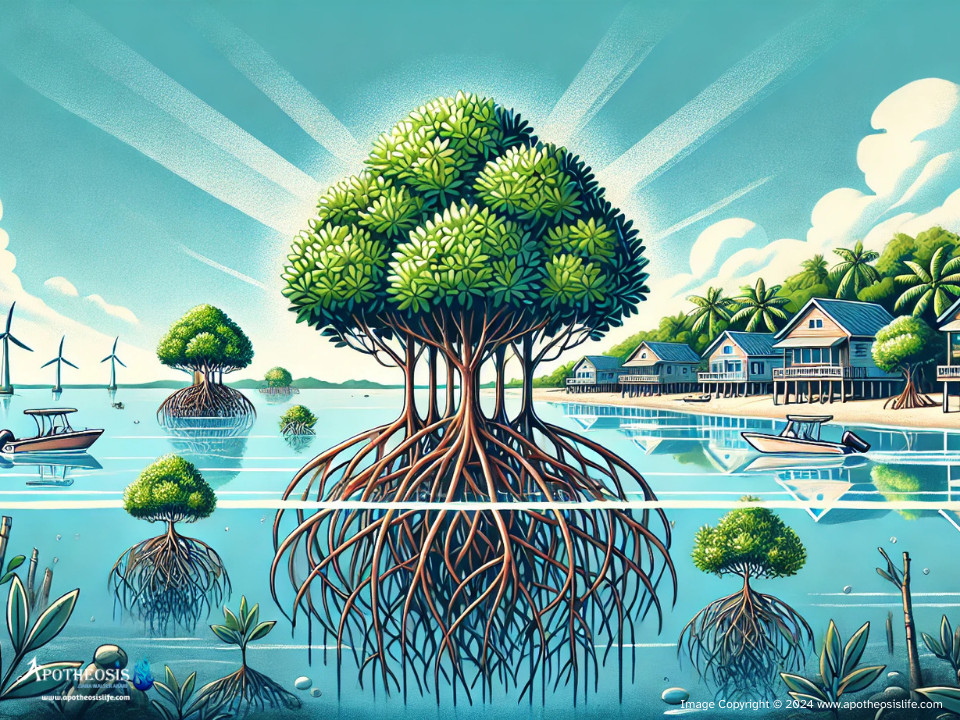For Reference: The Importance of Soil Health for a Sustainable Future
Mangroves, often referred to as “nature’s shield,” are unique ecosystems that play a vital role in protecting coastal communities. Found at the intersection of land and sea, mangroves serve as a natural barrier against storms, support biodiversity, and provide essential resources for millions of people. Despite their immense value, mangroves are under constant threat from human activities and climate change, underscoring the urgent need for their preservation.
What Are Mangroves?
Mangroves are salt-tolerant trees and shrubs that grow in intertidal zones along tropical and subtropical coastlines. Their complex root systems anchor them in place, allowing them to thrive in conditions where few other plants can survive. These ecosystems are home to a wide variety of wildlife, including fish, crabs, mollusks, and birds, making them critical biodiversity hotspots.
How Mangroves Protect Coastal Communities
1. Natural Defense Against Storm Surges and Flooding
Mangroves act as a buffer, reducing the impact of storm surges, hurricanes, and tsunamis on coastal communities. Their dense root systems dissipate wave energy, significantly lowering the risk of flooding and erosion. Studies have shown that mangroves can reduce wave heights by up to 66%, providing crucial protection to vulnerable areas.
2. Erosion Control
The intricate root networks of mangroves stabilize coastal soils, preventing erosion caused by tides, waves, and storm surges. By holding sediment in place, mangroves help maintain the integrity of coastlines, protecting both natural habitats and human settlements.
3. Carbon Sequestration
Mangroves are among the most effective ecosystems for capturing and storing carbon dioxide. Known as “blue carbon” ecosystems, mangroves sequester large amounts of carbon in their biomass and soil, helping to mitigate climate change. By reducing atmospheric CO₂ levels, they contribute to long-term climate stability.
4. Support for Livelihoods
Many coastal communities rely on mangroves for their livelihoods. Mangroves provide habitat for fish and shellfish, which are essential for local fisheries. They also supply timber, honey, and other resources, offering economic benefits to millions of people globally.
5. Water Quality Improvement
Mangroves filter pollutants and excess nutrients from the water, improving overall water quality in coastal areas. This natural filtration system supports healthier marine ecosystems and reduces the impact of human activities on nearby coral reefs and seagrass beds.

Image Copyright © 2024 www.apotheosislife.com
Threats to Mangroves
Despite their importance, mangroves face numerous threats:
Deforestation: Mangroves are often cleared for aquaculture, agriculture, and urban development. This destruction not only reduces their ability to protect coastlines but also contributes to carbon emissions.
Pollution: Industrial and agricultural runoff pollutes mangrove habitats, affecting their health and biodiversity. Oil spills and plastic waste are particularly harmful to these ecosystems.
Climate Change: Rising sea levels, increasing temperatures, and changing weather patterns pose significant risks to mangroves. Saltwater intrusion and flooding can disrupt their delicate balance, leading to habitat loss.
Unsustainable Practices: Overharvesting of mangrove timber and other resources can weaken their ability to function as protective barriers, making coastal communities more vulnerable to natural disasters.
Efforts to Protect and Restore Mangroves
1. Community-Based Conservation
Engaging local communities in mangrove conservation is crucial. Many successful projects involve training communities in sustainable harvesting practices, reforestation, and habitat management.
2. Reforestation Initiatives
Replanting mangroves in degraded areas helps restore their ecological and protective functions. Organizations and governments worldwide are investing in large-scale reforestation projects to rebuild mangrove forests.
3. Protected Areas and Legislation
Establishing marine protected areas (MPAs) and enforcing regulations against illegal logging and pollution can safeguard mangroves from further destruction.
4. Education and Awareness
Raising awareness about the importance of mangroves can inspire collective action to protect these ecosystems. Educational campaigns and ecotourism initiatives often highlight the role of mangroves in coastal resilience and biodiversity.
Preserving and restoring mangroves is a critical step toward building climate-resilient coastal communities. As natural barriers, mangroves provide an affordable and sustainable alternative to artificial infrastructure like seawalls. By prioritizing their conservation, we can protect millions of people from the devastating effects of climate change while ensuring the long-term health of marine ecosystems.
Details of the Featured Image
A vibrant mangrove forest with exposed roots in shallow waters, coastal homes in the distance, and a clear blue sky, symbolizing the balance between natural ecosystems and human settlements.
Image Copyright © 2024 www.apotheosislife.com
Author
Ziara Walter Akari
© www.apotheosislife.com
Citations
- Wave Reduction by Mangroves
International Union for Conservation of Nature (IUCN). “Mangroves for Coastal Defense.” Available at: https://www.iucn.org/. - Carbon Sequestration in Mangroves
United Nations Environment Programme (UNEP). “Blue Carbon Ecosystems.” Available at: https://www.unep.org/. - Economic Value of Mangroves
Food and Agriculture Organization (FAO). “The State of the World’s Mangroves.” Available at: https://www.fao.org/. - Mangrove Restoration Efforts
World Wildlife Fund (WWF). “Restoring Mangrove Ecosystems.” Available at: https://www.worldwildlife.org/.
